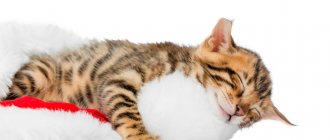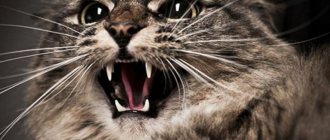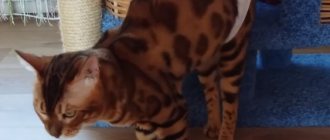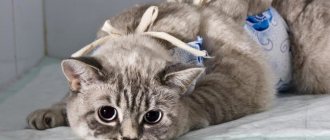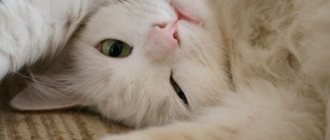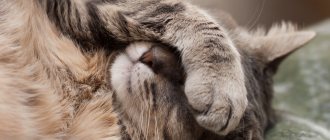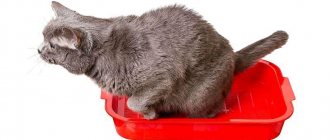If a cat is breathing with its mouth open, there may be natural physiological or pathological reasons for this. Conditions in which a cat suffocates are poisoning, overheating, injuries to internal organs, neoplasms or a foreign body in the nasopharynx, allergies, diseases of the heart and respiratory system. The owner must know what alarming symptoms are and be able to provide first aid. A veterinary clinic specialist will conduct a diagnosis and determine the reason why the cat is sticking out its tongue.
According to veterinarian statistics, 10% of cats with breathing problems are diagnosed with cardiovascular diseases.
Why does a cat breathe through its mouth?
The reasons why a cat opens its mouth and breathes like a dog with its tongue hanging out are:
- Physiological, when rapid breathing is caused by natural processes in the body.
- Pathological, in which the cat breathes with its mouth open due to illness or injury.
Physiological reasons
A cat breathes through its mouth under the following circumstances:
If the female is expecting offspring, then such a symptom is a sign of imminent delivery.
- Physical exercise. In kittens and adult cats, the frequency of breathing increases after too active games or running. When a pet runs, a lot of energy is consumed and all organs begin to function faster. The body needs an increased amount of oxygen, since cats do not know how to accumulate it. Therefore, if the cat has been running, it breathes quickly and its tongue sticks out.
- Dream. During the deep sleep phase, all the cat’s muscles relax, including the maxillofacial muscles. This causes the jaw to drop and the tongue to stick out. The Maine Coon sleeps so often, which is considered a feature of the breed. If a cat sleeps with its tongue hanging out and makes a sound, this is natural. Kittens sleep and show their tongues because they have a strong sucking instinct.
- Pregnancy and childbirth. If a pregnant cat breathes through her mouth, this means that the fetuses are pressing on the diaphragm and it is difficult for her to breathe. Mouth breathing indicates the beginning of contractions. The female walks restlessly, meows, and looks for a comfortable place. If heavy breathing appears after childbirth, this may be the onset of eclampsia and the animal needs emergency veterinary care.
- Stress. Adrenaline is released into the blood, causing the heart to work harder and breathing to increase.
- Death. In a state of agony, the cat sticks out its tongue and often breathes through its mouth. When a pet dies, the heart begins to contract worse, causing hypoxia.
Pathological factors
Poisoning
A smoking owner with his bad habit can provoke such a manifestation of smoke poisoning in his pet.
If a cat is breathing heavily and opens its mouth slightly, this may indicate that toxic substances have entered the body: alkalis, acids, rodent poisons, household chemicals, medications that the pet accidentally swallowed. A cat can also be poisoned by gas, combustion waste, even nicotine if the owner smokes a lot indoors.
Overheating
In hot weather, animals often overheat, especially if the owner leaves the pet in the car or on a closed balcony. Most often, long-haired cats suffer - Persian, Angora, Siberian. Hairless breeds also overheat and stick out the tip of their tongue. Therefore, in the summer, you should purchase a cooling mat for your pet.
Internal organ injuries
This is a deadly condition in which there may be no external changes. The cat pulls out its tongue and begins to breathe through its mouth after a fall from a height, a car injury, broken ribs, a ruptured diaphragm, or traumatic brain injury. With such pathologies, pulmonary edema often develops, which often provokes death. And also a protruding tongue indicates an accumulation of fluid in the pleural area.
Polyps in the nasopharynx or foreign body
A cat breathes heavily with its mouth open if there are polypous processes in the nose and nasal inhalation is difficult. Polyps grow, occupying the space of the nasopharynx, which is why the cat wheezes and the mouth opens even in sleep. Small objects that the animal sniffs also accidentally get into the nasal sinuses. A foreign body sometimes gets stuck in the throat (fish bones, fragments of toys).
Allergic reaction
If a cat constantly sticks out its tongue, watery eyes, itchy skin, swelling of the throat or mucous membranes appear, this is the immune system’s response to the allergen. The level of histamine increases, which dilates blood vessels, causing respiratory activity to become more frequent. Main agents:
- nutritional supplements;
- household chemicals;
- cosmetics for cats and people;
- medicines;
- dairy products;
- helminths and skin parasites.
Diseases of the heart and respiratory system
The cause of this pathology may be helminths - heartworms.
The cat's tongue sticks out and difficulty breathing occurs with cardiomyopathy, when the structures of the organ thicken, disrupting coronary blood flow.
Dirofilariasis is dangerous, in which worms are localized in the cavity of the heart. Often, a cat breathes through its mouth due to pathologies of the respiratory system - pneumonia, bronchitis, pulmonary thromboembolism, laryngeal stenosis.
First aid
In addition to the above private signs, the cat owner’s anxiety and concern should be caused by the following symptoms, common to all conditions that threaten the pet’s life:
- the cat is apathetic and lethargic;
- frequent vomiting;
- cough is dry or with bloody sputum;
- the cat shows signs of anxiety and fear.
If these symptoms are present in addition to difficulty breathing, the most effective help for your pet will be to take him to the clinic as soon as possible or call a doctor at home. During transportation or while waiting for help, the cat should be placed on its side and, if possible, its mobility should be limited.
It should be remembered that you cannot hesitate and waste time. Prolonged hypoxia entails irreversible changes in the brain, which will lead to the death of the pet.
What to do if a cat pulls out its tongue?
A sufficient volume of water is an important condition for improving the condition of the animal when overheated.
When a cat sticks out its tongue due to a foreign body, it should be carefully removed. The object is pulled out with tweezers. If a foreign object has moved strongly into the trachea, the animal should be turned upside down with its hind legs and shaken a little. If the cat overheats, place it in a cool place and give it plenty of water. In other cases, emergency veterinary care is always required.
Features of the structure of the cat’s oral cavity and its tongue
The oral cavity of representatives of this family is formed:
- The tongue, which is an elongated movable organ located at the bottom of the mouth, with its base attached to the body of the hyoid bone, and the free tip located in the anterior zone of the jaw. On its surface there are papillae - special mushroom-shaped structures with tiny holes or pores leading to taste buds. The tongue is predominantly formed by bundles of muscles, which are interspersed with hard connective and fatty tissue. It is penetrated by many blood vessels. It is surrounded by the openings of the ducts of the salivary glands, through which saliva enters the oral cavity. This organ is responsible for many functions: moving food in the mouth, helping with chewing and swallowing, delivering liquid to the oral cavity when drinking, determining the taste of food through taste buds, regulating body temperature (by moving over the tongue in the back and front directions, the air is cooled , evaporating saliva), cleaning the fur.
- Teeth located along the outer boundaries of the oral cavity, the upper of which are fixed in the maxillary bone, and the lower ones in the mandibular bone. Each of these bone formations consists of pulp, dentin, enamel and cementum. The tooth root is held in the bony socket of the jaw by periodontal ligaments of connective tissue. One tooth may have one or more roots. Kittens have 26 milk units, adult animals have 30 permanent ones: 12 sharp incisors, 4 long canines, 10 premolars, 4 molars. Functions of teeth: grinding and chewing food. The incisors are responsible for biting off food, the canines are for piercing and tearing it, the premolars are for rubbing, grinding and chewing food, and the molars are for final chewing.
- The mouth, used for receiving food and its primary processing. It is the gateway to the gastrointestinal tract. A cat's mouth is located in the lower front part of the snout between the maxillary and mandibular bones. It is formed by the space behind the teeth and gums, lips and cheeks. The main part of the mouth is bounded above by the hard and soft palate, on the sides and in front by the teeth and lips, and below by the tongue and adjacent tissues. The mouth is responsible for the production and secretion of saliva, which moistens food and helps form portions of it. It contains enzymes that help digest food and cleanses the tongue. Through the mouth, additional oxygen is supplied to the cat's respiratory system if necessary.
- Membranous mucous membrane. The upper part of the oral cavity is the palate. Its anterior part, which is formed by mucous-covered bone, is the hard palate, separating the oral cavity and nasal passages. The soft posterior region is the soft palate formed by the flexible fold of mucous membrane between the back of the mouth and nasal cavity.
- The lips, with the help of which the animal picks up food, throwing it into the oral cavity.
- Cheeks.
- Numerous small glands, including the sublingual salivary gland, which is located under the tongue.
Stress
The cause may be stress in cats. We will look at the symptoms and treatment below.
If the pet is stressed, the tongue will stick out. For example, when driving a car, if the cat is afraid, then the tongue will hang out the whole way. Fear, nervous shock, negative emotions are the reasons that cause stress in cats. When an animal is nervous, the following symptoms appear:
- tongue sticking out;
- the cat is shaking;
- the pet is trying to hide;
- meows constantly.
If the cat is scared, the symptoms may recur. Therefore, the animal requires treatment. He needs to be provided with complete rest. If necessary, the veterinarian will prescribe sedatives.
The cat is afraid to ride in a car: signs
Most pets are vocal about their fear. Many owners know that a cat's hysteria associated with a car ride can last the entire trip - sometimes for several hours. Heartbreaking meowing, the desire to break free and run away, sudden aggression - this is how a cat’s fear manifests itself. In addition, most pets begin to salivate excessively when they panic. Many cats breathe with their tongues hanging out and their mouths open, like dogs. Wet paws (after all, cats only sweat through their pads), clumps of fur, trembling - all these are signs that your cat is deathly afraid of such trips.
Dangerous discharge from a cat
If oxytocin was used during labor and the discharge is bright red, then this 100% means tissue rupture, which is a threat to the pet’s life and requires immediate assistance from a veterinarian.
If the discharge is thick with green spots, then this indicates inflammation of the walls of the uterus as a result of infection or incomplete release of the placenta. In this case, treatment with antibiotics or surgery is prescribed.
Discharge of yellow and gray colors means inflammation of the uterus. The disease is dangerous. A high temperature rise occurs, the cat begins to hide, meows heavily and, if inactive, ends in death.
Note! If the affected area is large, the uterus must be removed.
Diagnostics
Diagnostic methods in the clinic are aimed at identifying the causes of choking, coughing and shortness of breath and consist of:
- collecting anamnesis (finding out medical history). At this moment, the main role is assigned to the cat's owner. It is he who must tell about the signs, frequency, rhythm, strength of cough and shortness of breath, how long ago the first case was recorded, whether there is discharge and what other signs were recorded in the animal; • examination and palpation (oral and nasal cavity, trachea and esophagus, thoracic cells for integrity);
- auscultation (listening) of the bronchi and lungs;
- thermometry;
- if necessary, chest X-ray examination;
- performing endoscopy of the trachea;
- carrying out bacterial culture of nasal secretions for subtitration of microflora sensitivity to antibiotics;
- general blood analysis;
- blood chemistry;
- ultrasound examination of the chest cavity;
- analysis of fecal matter for worm eggs;
- thoracentesis (taking the contents of the chest cavity for examination).
Of all the listed diagnostic methods at home, you can carry out inspection, palpation, thermometry and auscultation. Often these methods are not sufficient to establish a diagnosis and prescribe treatment.
If a cat is choking after running, the veterinarian will perform an ultrasound of the heart, an echocardiogram, radiography, rhinoscopy, a general or biochemical blood test, and a stool test for helminths. The doctor also listens to heart sounds, examines the mucous membranes of the mouth and eyes, palpates the abdomen, ribs, and skull bones. Finds out what the cat eats and whether there was contact with pesticides. The foreign body is removed immediately.
Pathological causes
It happens that owners observe breathing problems in their cat for quite a long time. However, the factors from the above list are absent. Why, in this case, can the cat breathe heavily, often, sticking out its tongue? Here are the most common dysfunctions in which this symptom appears :
- a foreign body that has entered the respiratory tract and blocked the air supply;
- painful lesions of the oral mucosa (mechanical damage, ulcers, rashes, fistulas, inflammation);
- ARVI and similar ailments, in which mucus accumulates in the nose and other parts of the respiratory tract (oxygen is not easy to reach its destination, and the cat breathes with its tongue sticking out to get more air);
- lung pathologies (inflammation, edema, tumor, pulmonary failure);
- cardiovascular diseases (angina pectoris, coronary artery disease, hypotension, hypertension);
- injuries to the ribs and muscles in the area of the lungs, as a result of which the latter are compressed, their volume decreases, the body does not have enough oxygen, so the cat breathes with its tongue hanging out;
- dysfunction of the brain, namely the part of it that is responsible for breathing;
- poisoning, in which the general condition of the body leaves much to be desired, and malfunctions in the functioning of almost all systems are observed.
Cats stick out their tongues like dogs and breathe heavily, frequently, trying to take in more air when the body is starved of oxygen. The animal instinctively tries to escape from hypoxia, which is destructive for it. If this condition continues for a long time, the pet may even die.
Therefore, if you notice that your cat is breathing abnormally—opening its mouth wide and sticking out its tongue—you need to show it to the doctor as soon as possible. He will prescribe an examination and then select adequate treatment methods. Amateur action in this case is unacceptable - the risk of losing a pet is too high.
Transportation to the veterinary clinic and treatment
Whatever the diagnostic methods, they should be carried out in the clinic. Treatment should be prescribed based on the results of clinical and laboratory tests. It may consist of the following:
- antibiotics (for inflammatory processes);
- expectorants and mucolytic drugs;
- antiviral drugs (for viral infections);
- immunomodulator drugs;
- surgical intervention (stenting) for tracheal collapse;
- anthelmintics when detecting helminthic infestation.
The owner of the animal can independently, at home, give the cat a tablet, syrup, or administer intramuscular medication prescribed by the doctor.
If the treatment involves surgery, the clinic will provide it, as well as care in the postoperative period.
When transporting to a veterinary clinic, it is necessary to ensure as much fresh air as possible. You need to transport your pet in a carrier (if it does not cause stress). There is no need to hug or cuddle your pet.
If breathing is difficult, the process of inhalation and exhalation is difficult for the animal, and constrained movements will only aggravate the situation.
At the veterinary clinic, the pet will be placed in an oxygen chamber or allowed to breathe oxygen using a special mask. Sometimes urgent surgery and artificial ventilation are required.
If the cause of the disorder is a foreign body entering the respiratory tract, the veterinarian will be able to carefully remove it.
In other cases, after providing first aid, the veterinarian will collect an anamnesis from the cat’s owner and prescribe the necessary examination.
After a complete examination, the veterinarian will determine the true cause of the disease and prescribe treatment.
Breathing disorders are a serious pathological condition that requires a comprehensive examination and proper treatment. You won’t be able to solve the problem yourself at home without harming your pet.
If there is difficulty breathing, the pet will be allowed to breathe oxygen to identify the problem.
Functional brain disorders
Veterinarians identify the causes that lead to disruption of the brain and nervous system:
- traumatic brain injury;
- past infectious diseases;
- stroke.
The above reasons lead to a lack of coordination: the cat cannot independently control movements or control muscles. So he sticks out his tongue.
Veterinarians offer a small test that helps make sure that your cat has no neurological problems. If the animal sticks out its tongue, you need to touch it a little. If there are no neurological problems, the cat will quickly hide its tongue. If the actions do not bring results, we can talk about a pathological signal from the body.
Additional symptoms
Whatever the cause, cough and shortness of breath cannot diagnose the disease. In this case, the complex clinical picture should be considered. When collecting information about the disease, not a single symptom should be discarded.
To make a diagnosis, you should pay attention to:
- general condition (depression, lethargy, anxiety);
- food intake (reduced or the animal refuses it completely);
- drinking water (increased thirst may indicate diabetes, and choking is an additional symptom from dry mucous membranes);
- temperature indicators (an increase in general temperature may indicate inflammatory processes in the lungs and bronchi);
- nasal discharge (mucous, purulent);
- discharge from the eyes (viral rhinotracheitis, toxoplasmosis);
- diarrhea or constipation (bacterial or viral infection, toxoplasmosis, toxocariasis).
READ Duphalac for constipation in cats: instructions for use
Wheezing when breathing
Wheezing when breathing can be dry and wet (squelching). To hear better, you need to use a stethoscope or at least put your ear to your chest.
The cause of inflammatory processes can be either hypothermia or overheating of the animal. At this moment, the body’s resistance decreases, and the virulence of microorganisms increases.
Dry wheezing indicates initial inflammatory processes in the bronchi and lungs. At this moment, the mucous membranes are dry, and their friction is expressed by wheezing, and the cough is manifested by barking sounds. After some time, exudate begins to ooze out and the wheezing becomes moist. At this time, expectoration occurs.
The cough becomes softer, in this case they call it a wet cough. The inflammatory process is always accompanied by an increase in body temperature, depression, and refusal to feed. Initially mucous discharge begins to flow from the nasal openings, and then fibrinous and purulent. The nostrils become covered with dried crusts, which make breathing even more difficult.
Difficulty breathing and wheezing can occur with viral rhinotracheitis. In this case, a whole complex of symptoms is recorded. However, all of them may not be typical, so diagnosis should be carried out by a specialist.
The owner, when he sees a cat coughing violently and showing signs of suffocation, is very often at a loss.
A cough and a tongue outstretched in a cat cannot be a diagnostic symptom, it’s just something that makes the animal feel better. This is often how cats cough during an asthmatic attack. Rapid bronchospasm makes breathing difficult, and the animal reacts by coughing. After a few minutes, the spasm gives way to relaxation and the animal calms down.
If this happens for the first time, there is no need to be afraid, but you should consult a doctor.
Shortness of breath and difficulty breathing during sleep has the same causes as all others. However, if the cat sleeps separately from the owner, then monitor how often her exacerbation becomes difficult.
While awake, the cat often licks nasal discharge with its tongue and this makes it impossible for them to dry out. During sleep, crusts block the nasal passages, and this can cause difficulty breathing.
It’s a completely different matter if the shortness of breath is so severe that the cat wakes up the whole family at night. Immediate contact to the clinic for a full examination is the best method of help.
- Cough
- Labored breathing
- Blue gums
- Fatigue
- Weight loss
- Poor appetite
- Excessive thirst or frequent urination
- Vomit
- Diarrhea
When your cat is breathing rapidly and you, not knowing what to do, are looking for advice on this topic on the Internet on forums, we recommend not to self-medicate or experiment on your beloved cat. The fact is that there are many reasons for tachypnea in an animal, and the consequences of your experiment may disappoint you and your family.
How to protect animals from the heat
The most important thing is to stay cool and hydrated. Make sure that the animal always has water in its bowl; in hot weather, constantly change the water to keep it cool. But the water should not be icy! It will be good to periodically wipe with a damp cold cloth those places where there is less hair (head, ears, armpits, paws, belly).
Don't water your dog or cat! This is only temporary relief. Wet wool interferes with the ventilation process and turns into a greenhouse. And the animal may overheat even more. In addition, a shower with a hose can lead to illness in the animal - dogs, like us, can get pneumonia or inflammation of the genitourinary system from hypothermia. By the way, an air conditioner or fan is no less dangerous.
Doctors do not recommend cutting animals. A seasonal haircut is possible, but not with a clipper. This is a false stereotype; often such attempts to make life easier for a pet in the heat lead to colds, and also to burns of skin not accustomed to the sun’s rays, and even to oncology. But constantly brushing long-haired dogs and cats in hot weather is very useful! Help get rid of thick undercoat, clean wool allows air to pass through better.
Switch the animal to a light diet. In the heat, we ourselves don’t want to eat a lot, and our pets don’t need to be overloaded either. Animals themselves know how to regulate their needs; they lose their appetite. Use dry food, kefir. In hot weather it is better to feed not in the morning, but in the evening, when it is cooler. The portion should also be reduced.
